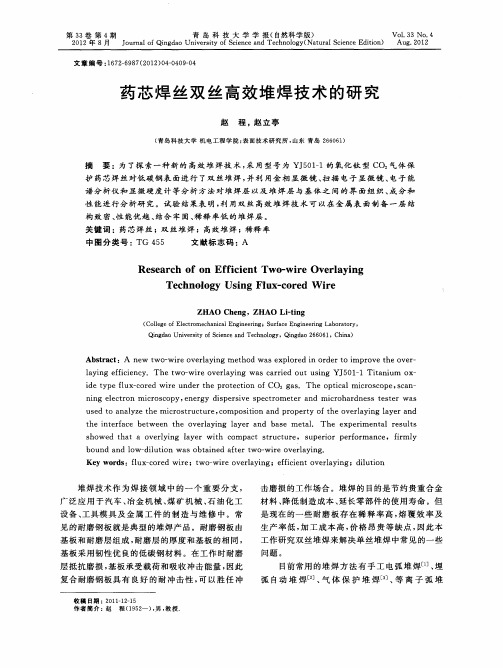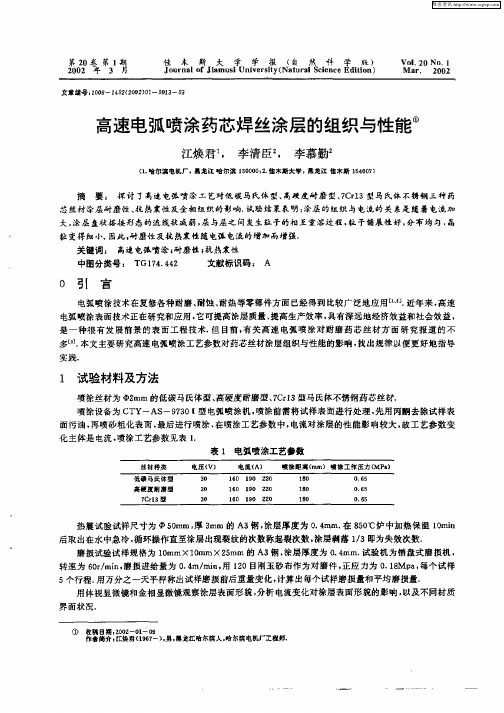高耐磨合金钢电弧喷涂药芯焊丝及应用研究
替代电镀铬的高速电弧喷涂3Cr13涂层的耐磨性能研究

中国石油大学胜利学院本科毕业论文替代电镀铬的高速电弧喷涂3Cr13涂层的耐磨性能研究学生姓名:学号:专业班级:材料成型及控制工程2班指导教师:2013年6月5日替代电镀铬的高速电弧喷涂3Cr13涂层的耐磨性能研究摘要镀铬层有着硬度高、耐磨性好和镀层色泽经久不变等特点,但工艺电流效率低,另外六价铬对人体和环境有较大的危害性,国内外研究者想用其它镀层取代它。
高速电弧喷涂技术是近年来发展起来的新型热喷涂技术,该技术具有优质、高效、低成本等特点。
本文实验对高速电弧喷3Cr13涂层进行了组织及性能分析,并与电镀硬铬工艺、性能成本进行了对比。
研究结果表明:高速电弧喷涂3Cr13涂层表面平整无无缝隙、涂层均匀.在涂层硬度、涂层结合力、耐磨性能方面高速电弧喷涂3Cr13涂层都接近甚至优于电镀硬铬层。
所以,用高速电弧喷涂技术代替电镀铬技术具有良好的发展前景。
关键词:电弧喷涂;硬铬;3Cr13;耐磨性能;涂层Study on wear-resistant resistance of 3Cr13 coating by arc spraying for replacing hard chrome platingABSTRACTChrome layer has a hardness, abrasion resistance and good coating characteristics of the same color perishable.However, the low efficiency of current, In addition to human and environmental hexavalent chromium a greater danger, many researchers would like to replace it with other coating. High-speed electric arc spraying technology developed in recent years is a new type of thermal spray technology, This technology has the characteristics of high-quality, high efficiency, low-cost, and so on. In this paper, the experimental high-speed electric arc spraying 3Cr13 coating for the organization and performance analysis, And compare with hard-chrome plating technology, performance and cost.The results show that, 3Cr13-arc spraying the surface coating formed a seamless, coating uniformity. In coating hardness, coating combination of wear resistance in high-speed arc spraying 3Cr13 coatings are close to or even better than that of the hard chromium plating.So,the arc spraying with high-speed chrome plating technology instead of technology has good prospects for development.Keywords: Arc spraying; alternative hard chrome plating; 3Cr13; wear resistance目录第1章前言 (1)1.1 电镀硬铬的用途及发展现状 (1)1.2 电镀硬铬的缺点 (3)1.3 热喷涂技术 (3)1.3.1 定义 (3)1.3.2喷涂材料 (4)1.3.3 涂层功能 (4)1.3.4 热喷涂技术在冶金工业中的开发与应用 (6)1.4 电弧喷涂优点 (12)1.5 本文研究的目的、意义及内容 (13)第2章实验原理与方法 (14)2.1 电弧喷涂原理 (14)2.2 电镀铬工艺流程及参数 (15)2.3 金相微观组织分析 (15)2.4 硬度测量 (17)2.5 涂层结合原理与测量结合力方法 (18)2.6 冲蚀实验原理与方法 (19)第3章实验结果分析与讨论 (21)3.1组织分析 (21)3.2性能分析 (26)3.2.1 硬度 (26)3.2.2 界面结合力 (26)3.2.3 耐磨性能 (27)3.3 高速电弧喷涂3Cr13涂层与电镀硬铬技术对比 (31)3.3.1 涂层性能 (31)3.3.2 其他性能 (32)第4章结论 (33)致谢 (34)参考文献 (35)第1章前言1.1 电镀硬铬的用途及发展现状1 电镀硬铬的用途铬是一种微带天蓝色的银白色金属。
药芯焊丝双丝高效堆焊技术的研究

V 13 o 4 o. 3N .
Au . 0 2 g 2 1
文章 编号 :6 2 6 8 ( 0 2 0 —4 9 0 1 7—9 7 2 1 )40 0—4
药 芯 焊 丝双 丝高 效 堆 焊 技 术 的研 究
赵 程 , 立亭 赵
( 岛科 技 大 学 机 电 工 程学 院 ; 面 技 术 研 究 所 , 东 青 岛 2 6 6 ) 青 表 山 6 0 1
表 2 双 丝 堆 焊 工 艺 参 数
Ta l Pr c s a a t r ft e t — r v ra i g be2 o e sp r me e s o h wo wie o e ly n
电弧 热被用 来加 热 熔 化母 材 金 属 , 因此其 堆焊 层 的稀 释率很 低 , 敷效 率也 高于单 丝堆 焊 , 就大 熔 这
表 1 基 体 与 焊 丝 化 学 成 分对 比
Ta l Co r s fc e c lc mp sto b el nt a to h mia o o ii n b t e a e me a n l i r e we n b s t la d wed ng wie
i y e fux c e r de t p l - or d wie und rt r e to o e he p ot c in fCO2 g s a .The o i a ir s op s a — ptc lm c o c e, c n
n ng e e t o m ir s o y, ne g ipe sv pe t o e e n i r h r e s t s e s i l c r n c o c p e r y d s r i e s c r m t r a d m c 0 a dn s e t r wa
药芯焊丝生产工艺及设备的国内外进展

药芯焊丝生产工艺及设备的国内外进展【摘要】该文就国内外药芯焊丝的生产状况展开分析,实现其国内外生产技术环节、设备应用环节等的探究,以满足现实工作的需要,实现现实公司的药芯焊丝生产体系的优化,实现其内部各个环节的有效协调。
【关键词】药芯焊丝存在问题设备管理生产优化进展探究1 药芯焊丝的应用状况(1)药芯焊丝是一种良好的焊接材料,这与其良好的运营优势有关,其具备比较高的生产效率,在焊接过程中,能保证产生的质量,实现其成本环节的有效控制,其具备良好的现实应用性。
随着时代的发展,药芯焊丝应用体系不断得到优化,这几年来说,药芯焊丝应用逐渐普及到了社会生活的各个领域,在国际社会上也拥有比较高的知名度。
随着工业经济的发展,焊材不断被得到应用,无论是焊材总量还是应用规模都在不断扩大。
随着现代化经济的发展,造船工业、石油化工工业的发展,实现了对药芯焊丝需求的增加,这大大推动了药芯焊丝产业链条的完善发展。
早期的药芯焊丝应用技术是不成熟的,无论是其制造方法还是其他的应用渠道都是比较狭窄的。
随着科学技术的发展,无缝型药芯焊丝不断得到应用,实现了现实工作效益的提升。
这种焊丝实现了无缝钢管的应用,进行其长度的适当截取,在应用过程中,进行管内芯丝或者其他材料的补充,最后再进行管子两端的封闭,实现其药芯焊丝制作模式的优化。
(2)在药芯焊丝的早期制作过程中,通过对模拔的应用,实现其焊丝的成形,这主要需要应用到拉丝模,通过挤压力的影响,进行成形,最近实现膏状涂料模式的应用,实现药粉的直接添加,在此应用前提下,这种截面焊丝是比较复杂的,但是其具备一定的应用效益,能够保证避免出现电弧不集中的现象,实现对熔滴过渡特性的减轻。
2 药芯焊丝生产工艺及其设备的发展研究(1)随着国际药芯焊丝生产技术的进步,一系列的新型药芯焊丝制作模式不断优化,也诞生了一系列的新型应用设备。
我们按照药芯焊丝的结构特点,可以进行有缝及其无缝型的药芯焊丝的制作。
我们通过对其原材料应用的划分,也可以进行相关制造工艺的分类,比如盘元法、冷扎带钢法等,通过其成形的特点,可以进行全连轧法、分模拔法的分析。
浅析电弧喷涂技术的应用及长效防腐

浅析电弧喷涂技术的应用及长效防腐检修分公司湛春强【摘要】随着热喷涂技术的日益发展成熟,热喷涂工艺方法的不断扩展,越来越多的防腐公司已开始此项技术的开发、研究、应用。
而电弧喷涂技术作为其一个重要分支,也是目前大型钢结构防护工程中防腐蚀寿命最长、寿命周期成本最低的防护涂层技术之一,以其技术优势和长期的经济性,应用范围进一步扩大,广泛运用于各行各业中。
关键词:电弧喷涂技术应用长效防腐1 前言电弧喷涂技术是新兴的表面工程学科中热喷涂技术的一个重要分支,也是一种材料表面防护和强化的新技术。
目前在欧、美等发达的工业国家已广泛应用电弧喷涂锌、铝及其合金进行钢铁构件的长效防护,并且已在桥梁、闸门、储油罐、船舶、工厂烟筒、电视发射塔等大型钢铁结构的防腐工程中取得较好的应用效果。
随着技术的日趋成熟,应用领域的不断扩大,成为当今大型钢铁结构件长效防腐的首选方法。
在日本神户举行的第十四届国际热喷涂会议上,将汽车、冶金和能源等工业领域作为热喷涂技术深化应用与重点开发的三大主题,表明了这项技术在扩充应用中的新动向。
我公司是一家具有防腐蚀施工综合一级资质的国有企业,专门负责化工设备、管道、大型钢结构件的防护工作。
受工程业务拓展的影响,长期以来均采用单纯的人工结合动力机械除锈、涂料涂装或玻璃钢防腐,施工手段比较贫乏,随着公司业务的不断对外发展,规模的日益扩大,新的施工技术和工艺的应用已成当务之急。
2电弧喷涂的技术原理电弧喷涂技术就是通过专用电源,使带电的耐腐蚀金属丝材产生电弧熔化,在1/1000—1/10000秒内,熔融金属的高温液滴被压缩空气喷吹、雾化、喷涂至预先喷砂除锈的钢铁构件表面,形成纯度高、结合力强的机械—冶金结合喷涂层,它对活泼的钢铁基体具有阴极保护作用。
然后在该喷涂层上均匀涂敷具有抑制腐蚀作用的专用封闭剂,它不仅能进一步隔绝腐蚀介质侵蚀基体钢铁,同时使电弧喷涂金属层与封闭涂层界面阻抗增大,耐腐蚀性能大为增强。
电弧喷涂防腐涂层的防腐原理为机械屏蔽和阴极保护联合作用。
高耐磨合金钢电弧喷涂药芯焊丝及应用研究

华中科技大学硕士学位论文高耐磨合金钢电弧喷涂药芯焊丝及应用研究姓名:戴明辉申请学位级别:硕士专业:材料工程指导教师:余圣甫2011-05-25华 中 科 技 大 学 硕 士 学 位 论 文摘要本论文研究成分配比不同的几种合金钢电弧喷涂药芯焊丝,在低碳钢表面进行喷涂形成高耐磨的高合金钢电弧喷涂涂层。
测试电弧喷涂涂层的显微硬度、耐磨粒磨损性能、孔隙率以及与基体的结合强度;通过金相显微镜、环境扫描电子显微镜(ESEM)、EDS能谱仪等分析手段研究了电弧喷涂涂层的微观结构;分析了Al、Ni、B对涂层性能以及组织结构的影响。
研究结果表明:喷涂药芯焊丝中Al含量的增加,并不能提高其结合强度。
Al 在电弧喷涂雾化阶段烧损较大,形成氧化铝,沉积在涂层表面时不利于金属雾化颗粒融合,成为夹渣,形成孔隙,降低涂层与基体的结合强度。
因此Al含量增加,涂层的孔隙率增加,显微硬度与耐磨性下降。
涂层中的B与Fe形成FeB与Fe2B的混合相,能与基体有效结合,与Ni形成Ni-Cr-B-Si系自熔合金,有良好的浸润性,因此B能促进涂层与基体的结合强度。
此外,B还与C形成B4C硬质相,还能与Cr形成硼铬化物CrB,Cr2B硬质相,分布在涂层中,提高涂层的耐磨性。
Ni在涂层中的主要作用是形成Ni-Cr-B-Si系自熔合金,提高涂层与基体的结合强度,对涂层的孔隙率、硬度以及耐磨性作用不明显。
通过对涂层表面的磨损形貌分析,表明涂层表面的磨损机理为微观切削磨损机理,磨粒在涂层表面主要产生压痕而不是切屑。
涂层中的孔隙与夹渣易于形成切屑,降低了涂层的耐磨性。
用研制的药芯焊丝对搅拌车的落料槽进行电弧喷涂,有效地提高了使用寿命,取得了良好的效果。
关键词:电弧喷涂;药芯焊丝;合金元素;耐磨性;结合强度华 中 科 技 大 学 硕 士 学 位 论 文AbstractIn the paper, we designed and investigated several alloy steel composition of flux cored wires for arc spraying. Alloy steel coatings with high wear resistance were deposited on low carbon steel surface. Micro-hardness, abrasive wear resistance, porosity, and the bonding strength of the arc sprayed coating were tested. Through the microscope, environmental scanning electron microscope (ESEM), EDS analysis, the microstructure of arc sprayed coatings was studied, moreover, the effects of Al, Ni, B on the coating performance and structure were also analyzed and assessed.The results manifested that with the increase of Al content, the bonding strength was not improved. In the arc spray atomization stage, Al was burned and transformed into aluminum oxide to deposit on the surface of the coatings. As aluminum oxide could not easily integrate with the metal aerosol particles and became slag, then a large number of pores formed, as a result, the bonding strength of the coating and substrate would reduce. And the loss was more than that for the exothermic reaction. Therefore, as the Al contents increased, the porosity of coating increased, and the hardness and wear resistance decreased.Since B combined with Fe to form the mixed phases FeB and Fe2B, which could effectively bind with substrate, and B and Ni could form the Ni-Cr-B-Si self-fluxing alloy system with good infiltration, so B could promote the bonding strength of coating and substrate. In an addition, B with C or Cr could form B4C or CrB,Cr2B, these hard phases was able to enhance wear resistance of the coating. While Ni was mainly used to form the Ni-Cr-B-Si self-fluxing alloy system, it could promote the bonding strength of coating, but its role to the porosity, hardness and wear resistance of coating was not obvious.According to the analysis of the wear of the coating surface, it was determined that the wear mechanism was micro-cutting wear, for the abrasives produced indentation but not chips on the coating surface. And the porosity and slag were conducive to the formation of chip, which finally reduced the wear resistance of the coating.The cored wire with the best performance in this paper was utilized for arc spraying华 中 科 技 大 学 硕 士 学 位 论 文on the drop chute of mixer which effectively improved the service life, and achieved good results.Key words: arc spraying; cored wire; alloy steel coating; wear resistance; bonding strength独创性声明本人声明所呈交的学位论文是我个人在导师指导下进行的研究工作及取得的研究成果。
超音速电弧喷涂表面合金化防腐技术研究

超音速电弧喷涂表面合金化防腐技术研究摘要:超音速电弧喷涂表面合金化防腐技术是一项新兴的防腐技术,由于提高了喷涂速度,使得涂层的防腐和耐磨性大大提高深受人们欢迎,本文对该技术进行了初步的研究,分析了它的工作原理、现实应用以及存在的问题。
关键词:超音速电弧喷涂防腐涂层一、超音速电弧喷涂的基本原理电弧喷涂是热喷涂技术的一种,电弧喷喷咀中包含这两根电线,操作时,接通电源,并且分别接上正负极,在两根电线的端点就会形成一个电弧,电弧温度理论上可以达到6000℃,在高温作用下,丝材被雾化成为微粒,此时在高速气流的作用下,雾化的丝材微粒从喷咀中喷出,由于所喷微粒温度很高,因此涂层密度高,结合牢固。
在电弧喷涂中又可以分为亚音速喷涂和超音速喷涂。
超音速喷涂是相对于亚音速喷涂来说的,以前多使用亚音速喷涂技术,亚音速电弧喷涂时,经电弧雾化的丝材微粒是以亚音速的速度从喷咀中喷出的,而超音速电弧喷涂技术,丝材微粒是以超音速的速度从拉伐尔喷咀喷出的,它是一个不断重复积累的过程,雾化的丝材微粒均匀分布在需要防腐的部件表层上,形成一个涂层,从而起到防腐耐磨的作用(如图1所示)。
电弧喷涂能够减少涂层的气孔以及氧化程度,同时还能节约涂层材料。
超音速电弧涂层主要用在有导电性的金属的防腐方面,例如锌铝、不锈钢、高铬钢等材料。
二、超音速电弧喷涂的雾化效果超音速电弧喷涂由于使用了拉伐尔喷嘴,使气流速度超过音速,从而使粒子流的速度也超过了音速。
速度提高了,所以雾化的粒子变得更小了,从而在金属面上的分布也就越均匀,由图2可见,粒子基本接近球形每个粒子之间的距离很小,分布较均匀。
高速度还使得涂层的强度大大提高,由于粒子速度很高,因此,粒子沉积时的冲击力就会很大,从而有利于提高活性区域的面积。
另外,高速粒子沉积时由动能转化而来的热能会大得多,从而也提高了涂层的结合强度。
图2 为超音速电弧喷涂3Cr13时粒子的形貌。
三、超音速电弧喷涂的材料1.金属线材目前超音速电弧喷涂表面合金化技术主要使用丝材,比较常用的有锌、铝、镁,还有一些新兴材料产生,例如铝镁锌丝材等。
防磨防腐新材料超音速电弧喷涂技术-管理资料

防磨防腐新材料超音速电弧喷涂技术-管理资料一、超音速电弧喷涂的原理电弧喷涂原理是利用两根连续送进的金属丝作为自耗电极,在其端部产生电弧作为热源,用压缩空气将熔化了的丝材雾化,并以超音速喷向工作件形成一种结合强度高、孔隙率低、表面粗糙度低的涂层的热喷涂方法,。
其工作原理与普通电弧喷涂(亚音速雾化)一样,超音速电弧喷涂是一个不断连续进行的熔化-雾化-沉积的过程。
但在雾化方式上,超音速电弧喷涂与普通电弧喷涂有根本的区别,即超音速电弧喷涂是采用超音速雾化。
其优点是:雾化效果好,雾化后的粒子细小均匀,速度高,有利于获得高质量的涂层。
超音速电弧喷涂采用拉伐尔喷嘴,将气流的速度从亚音速提高到超音速,加强了气流对粒子的加速效果,从而提高了粒子速度。
粒子速度对涂层的性能有很大的影响。
粒子速度高,粒子沉积时对基体的撞击作用就强,粒子变形就充分。
有利于粒子与基体、粒子与粒子之间的结合,从而提高涂层的结合强度和内聚强度;粒子速度高,粒子沉积前在空气中的飞行时间短,飞行中产生的氧化物就少,有利于粒子的结合,从而提高涂层的内聚强度,降低涂层的孔隙率。
粒子速度越高,越有利于获得高质量的涂层。
随着热喷涂设备的更新换代,粒子速度在不断提高,涂层的质量也不断得到改善。
超音速雾化减小了粒子的粒度,降低了涂层的粗糙度。
粗糙度是涂层的一项重要性能指标,它取决于雾化后粒子的粒度。
超音速雾化加强了气流对丝材端部熔化金属间的作用,雾化的粒子细小均匀,大大降低了涂层的粗糙度。
同时,粒子粒度的减小,也降低了粒子扁平化过程中的飞溅,有利于降低涂层的孔隙率。
超音速雾化是超音速电弧喷涂的出发点,是其与普通电弧喷涂的根本区别。
超音速电弧喷涂设备包括电源、喷枪、送丝机构及其附件,关键设备是超音速电弧喷枪。
我公司采用进口喷嘴,并且喷涂电流稳定,能在保证丝材雾化效果、涂层质量的前提下,一天的喷涂面积达到20m2。
电弧喷涂时,弧区的温度高达5000-6000℃,用气冷的方式对喷嘴进行冷却。
电弧金属喷涂与重熔技术在内燃机曲轴颈表面强化方面的应用

电弧金属喷涂与重熔技术在内燃机曲轴颈表面强化方面的应用[摘要]本文介绍了电弧金属喷焊技术的特点、原理,设备、工艺、材料的进展,电弧金属喷焊技术在内燃机曲轴颈表面强化方面的应用,提出了一个电弧金属喷焊技术的特例与实验数据。
[关键词]金属喷焊;金属喷涂;重熔技术;表面强化;维修;内燃机一、电弧金属喷焊技术的特点电弧金属喷焊技术包括金属喷涂和涂层重熔两个工艺过程。
在电弧金属喷涂过程中,金属丝材被电弧的加热并雾化,在高速气流带动下以机械镶嵌的形态堆积到工件表面。
而电弧重熔过程是采用热源(电弧)对涂层加热,使金属涂层再次熔融,并在金属工件表面重新结晶。
对金属涂层进行重熔能消除金属涂层中的孔隙、氧化物夹渣等等,使金属涂层与金属工件表面产生冶金结合,从而大幅度提高了金属表层的致密性和结合强度,也使金属表层的耐腐蚀、耐磨损和抗冲击性等性能得到大幅度的优化。
电弧金属喷涂是电弧金属喷焊技术的前期工序。
在这个工序中把电压加在两根金属丝上,使金属丝在喷枪中短路产生的电弧。
电弧作为热源,将金属丝前端熔化,然后利用高速气流将熔滴雾化,并喷射到工件表面,形成金属涂层。
金属喷涂层的结构是由无数变形扁平的粒子相互交错呈波浪式堆积而成的层状结构。
这是由于喷涂过程中,熔化或半熔化状态粒子与喷涂工作气体及周围环境气氛进行化学反应,使得喷涂材料经喷涂后会出现表面氧化物。
同时,变形扁平粒子的相互叠加产生搭桥效应,不可避免地在涂层中出现小部分空隙。
因此涂层的典型结构是由变形扁平微细的涂层材料堆积而成的层状结构,且中间央带着部分气孔和氧化物。
在金属喷涂层中存在着下列几种缺陷:①金属喷涂层是一种颗粒堆积的层状结构。
金属涂层的化学成分和晶体组织都属于非平衡状态,性能也不稳定;②由变形粒子堆积而成的金属涂层,不可避免地在其内部产生较多的裂纹;③金属涂层孔隙率比较高,耐磨性、耐腐蚀性和抗氧化性等性能都得不到可靠的保证;④金属涂层间以及金属涂层与金属工件的表面层之间都经常被氧化物类物质所隔离,涂层金属结合的主要形式为机械镶嵌式的结合。
高速电弧喷涂药芯焊丝涂层的组织与性能

摘
要 : 探讨 j高速 电弧 喷涂 I艺对低 碳 马 氏休 型 、 高硬度耐 磨 型、C 1 7 r3型马 氏体 不 错钢 三种 药
芯 丝材夯层 耐磨 性 、 热震性及 金相 组 织 的影响. 抗 试验 结 果表明 : 涂层 的组织 与 电流 的 关 系是 随羞 电流 加 大, 涂层 盘状 搭接 形 态 的流 线状 减 弱 , 与层之 间发生粒 子 的相互 重溶过 程 , 子铺 展 性好 , 布 均匀 , 层 粒 分 晶 粒 变得 细小. 目此 , 磨性 及抗 热震性 随 电弧 电流 的增加 而增 强. 耐
实践 .
1 试验材料及方法
喷潦丝材为 2 m的低碳马氏体型、 m 高硬度耐磨型、C 1 型马氏体不锈钢药芯丝材. 7 r3 喷涂设备 为 C Y-AS 93 电弧喷 涂机 , T - - 70I型 喷涂 前需将 试 样表 面进行 处 理 , 用丙 酮 去除试 样表 先
面污 油 , 喷砂粗 化表 面 , 再 最后 进行 喷涂 , 喷涂工艺参 数 中, 在 电流对 涂层 的性 能 影 响较大 , 工 艺参 数变 故 化 主体 是 电流 , 喷涂 工艺 参数 见表 1 . 表 1 电弧喷 涂工艺 参数
熔 化 越 充分 , 高速 气流 雾化 好 , 喷在 基体 上 的液态金 属铺 展越 好 , 层 颗粒 细 小结 台强 度 高 , 被 射 涂 孔隙 小 - 涂 层 凸凹 小 , 故而 使 耐 磨性 提 高. 另外 . 高硬 度 耐 磨 型药 芯丝 村 中存 在 大 量碳 化 物 形成 元 素 , 磨 性 高 耐 7 1 氏体 型药 芯丝 材与低 碳马 氏体 型药芯丝 材相 比. Cr3马 由于含碳量 不 同, 对耐磨 性 的贡献 也不 同. 表 2 涂层 平均磨损 量与 电弧 电流的关 系
一种抗高温耐磨线材的电弧喷涂装置原理

一种抗高温耐磨线材的电弧喷涂装置原理随着工业技术的不断进步,高温耐磨材料的需求日益增加。
特别是在一些高温、高压、高速运转的设备中,对材料的耐磨性和耐高温性能提出了更高的要求。
而电弧喷涂技术作为一种常用的表面改性方法,已经成为了提高材料性能的重要手段。
本文将介绍一种抗高温耐磨线材的电弧喷涂装置原理。
一、原理概述1. 电弧喷涂技术电弧喷涂技术是一种利用电弧能量来熔化涂层材料,并喷涂到基材表面的表面处理技术。
通过在气流中产生电弧,使喷涂材料熔化并喷射到基材表面,形成均匀、致密的涂层,从而提高基材的耐磨性、耐腐蚀性和高温性能。
2. 抗高温耐磨线材电弧喷涂装置抗高温耐磨线材电弧喷涂装置是一种特殊的电弧喷涂装置,其主要应用于在高温、高压环境下工作的设备部件的表面涂覆,以提高其耐磨性和耐高温性能。
二、装置组成及工作原理1. 装置组成该装置由电弧喷涂枪、喷涂材料供给装置、控制系统等部分组成。
2. 工作原理(1) 喷涂材料供给装置将抗高温耐磨线材作为喷涂材料,通过恒压或恒流的方式将喷涂材料输送到电弧喷头。
(2) 电弧喷涂枪的核心部分是电弧发生器和喷涂材料喷嘴。
电弧发生器在两个电极之间产生高温电弧,喷涂材料在电弧的作用下熔化并喷射到基材表面。
(3) 控制系统对整个喷涂过程进行监控和调节,确保喷涂质量和涂层厚度满足要求。
三、工作机理1. 电弧喷涂原理电弧喷涂是将喷涂材料熔化后,以高速气流喷射到基材表面的一种喷涂方法。
喷涂材料在电弧能量的作用下熔化,然后通过气流将熔融的喷涂材料喷射到基材表面,形成均匀、致密的涂层。
2. 抗高温耐磨线材电弧喷涂机理抗高温耐磨线材电弧喷涂是将特殊的抗高温、耐磨材料以线材的形式进行喷涂。
在电弧的作用下,线材被熔化并以高速喷射到基材表面,形成一层均匀、致密的耐磨、耐高温涂层。
四、特点与应用1. 特点(1) 抗高温:涂层具有良好的高温稳定性,能够在高温环境下长期稳定运行。
(2) 耐磨:涂层具有较高的硬度和耐磨性,能够有效提高基材的耐磨性能。
- 1、下载文档前请自行甄别文档内容的完整性,平台不提供额外的编辑、内容补充、找答案等附加服务。
- 2、"仅部分预览"的文档,不可在线预览部分如存在完整性等问题,可反馈申请退款(可完整预览的文档不适用该条件!)。
- 3、如文档侵犯您的权益,请联系客服反馈,我们会尽快为您处理(人工客服工作时间:9:00-18:30)。
华中科技大学硕士学位论文高耐磨合金钢电弧喷涂药芯焊丝及应用研究姓名:戴明辉申请学位级别:硕士专业:材料工程指导教师:余圣甫2011-05-25华 中 科 技 大 学 硕 士 学 位 论 文摘要本论文研究成分配比不同的几种合金钢电弧喷涂药芯焊丝,在低碳钢表面进行喷涂形成高耐磨的高合金钢电弧喷涂涂层。
测试电弧喷涂涂层的显微硬度、耐磨粒磨损性能、孔隙率以及与基体的结合强度;通过金相显微镜、环境扫描电子显微镜(ESEM)、EDS能谱仪等分析手段研究了电弧喷涂涂层的微观结构;分析了Al、Ni、B对涂层性能以及组织结构的影响。
研究结果表明:喷涂药芯焊丝中Al含量的增加,并不能提高其结合强度。
Al 在电弧喷涂雾化阶段烧损较大,形成氧化铝,沉积在涂层表面时不利于金属雾化颗粒融合,成为夹渣,形成孔隙,降低涂层与基体的结合强度。
因此Al含量增加,涂层的孔隙率增加,显微硬度与耐磨性下降。
涂层中的B与Fe形成FeB与Fe2B的混合相,能与基体有效结合,与Ni形成Ni-Cr-B-Si系自熔合金,有良好的浸润性,因此B能促进涂层与基体的结合强度。
此外,B还与C形成B4C硬质相,还能与Cr形成硼铬化物CrB,Cr2B硬质相,分布在涂层中,提高涂层的耐磨性。
Ni在涂层中的主要作用是形成Ni-Cr-B-Si系自熔合金,提高涂层与基体的结合强度,对涂层的孔隙率、硬度以及耐磨性作用不明显。
通过对涂层表面的磨损形貌分析,表明涂层表面的磨损机理为微观切削磨损机理,磨粒在涂层表面主要产生压痕而不是切屑。
涂层中的孔隙与夹渣易于形成切屑,降低了涂层的耐磨性。
用研制的药芯焊丝对搅拌车的落料槽进行电弧喷涂,有效地提高了使用寿命,取得了良好的效果。
关键词:电弧喷涂;药芯焊丝;合金元素;耐磨性;结合强度华 中 科 技 大 学 硕 士 学 位 论 文AbstractIn the paper, we designed and investigated several alloy steel composition of flux cored wires for arc spraying. Alloy steel coatings with high wear resistance were deposited on low carbon steel surface. Micro-hardness, abrasive wear resistance, porosity, and the bonding strength of the arc sprayed coating were tested. Through the microscope, environmental scanning electron microscope (ESEM), EDS analysis, the microstructure of arc sprayed coatings was studied, moreover, the effects of Al, Ni, B on the coating performance and structure were also analyzed and assessed.The results manifested that with the increase of Al content, the bonding strength was not improved. In the arc spray atomization stage, Al was burned and transformed into aluminum oxide to deposit on the surface of the coatings. As aluminum oxide could not easily integrate with the metal aerosol particles and became slag, then a large number of pores formed, as a result, the bonding strength of the coating and substrate would reduce. And the loss was more than that for the exothermic reaction. Therefore, as the Al contents increased, the porosity of coating increased, and the hardness and wear resistance decreased.Since B combined with Fe to form the mixed phases FeB and Fe2B, which could effectively bind with substrate, and B and Ni could form the Ni-Cr-B-Si self-fluxing alloy system with good infiltration, so B could promote the bonding strength of coating and substrate. In an addition, B with C or Cr could form B4C or CrB,Cr2B, these hard phases was able to enhance wear resistance of the coating. While Ni was mainly used to form the Ni-Cr-B-Si self-fluxing alloy system, it could promote the bonding strength of coating, but its role to the porosity, hardness and wear resistance of coating was not obvious.According to the analysis of the wear of the coating surface, it was determined that the wear mechanism was micro-cutting wear, for the abrasives produced indentation but not chips on the coating surface. And the porosity and slag were conducive to the formation of chip, which finally reduced the wear resistance of the coating.The cored wire with the best performance in this paper was utilized for arc spraying华 中 科 技 大 学 硕 士 学 位 论 文on the drop chute of mixer which effectively improved the service life, and achieved good results.Key words: arc spraying; cored wire; alloy steel coating; wear resistance; bonding strength独创性声明本人声明所呈交的学位论文是我个人在导师指导下进行的研究工作及取得的研究成果。
尽我所知,除文中已经标明引用的内容外,本论文不包含任何其他个人或集体已经发表或撰写过的研究成果。
对本文的研究做出贡献的个人和集体,均已在文中以明确的方式标明。
本人完全意识到,本声明的法律结果由本人承担。
学位论文作者签名:日期: 年 月 日学位论文版权使用授权书本学位论文作者完全了解学校有关保留、使用学位论文的规定,即:学校有权保留并向国家有关部门或机构送交论文的复印件和电子版,允许论文被查阅和借阅。
本人授权华中科技大学可以将本学位论文的全部或部分内容编入有关数据库进行检索,可以采用影印、缩印或扫描等复制手段保存和汇编学位论文。
保密□,在 年解密后适用本授权书。
本论文属于不保密□。
(请在以上方框内打“√”)学位论文作者签名: 指导老师签名: 日期:年月日日期:年月日华中科技大学硕士学位论文1 绪论1.1 课题研究背景与意义钢铁材料失效的三种方式为:断裂、腐蚀和磨损,每年世界钢材消耗的50%是因为磨损造成的。
通常意义上来讲,磨损是指零部件几何尺寸(体积)变小。
按照表面破坏机理特征,磨损可以分为磨粒磨损、粘着磨损、表面疲劳磨损等三个基本类型,而磨粒磨损在磨损类型中占据主要地位。
为了减少零件因表面局部损坏而报废,提高零件的使用寿命,世界各国都在研究提高零件表面性能的各种表面技术。
通过表面改性技术提高零部件表面的耐磨粒磨损性能是一种最通用的方式,而热喷涂技术是目前表面工程领域内表面改性的最有效的技术之一[1]。
热喷涂技术是利用热源将喷涂材料加热至熔化或半熔化状态,并以一定的速度喷射沉积到经过预处理的基体表面形成涂层,达到赋予基体表面特殊功能的目的。
热喷涂涂层具有耐磨损、耐腐蚀、耐高温和隔热等优良性能,并能对磨损、腐蚀或加工超差引起的零件尺寸减小进行修复。
依热源的不同,热喷涂可分为火焰喷涂、电弧喷涂、等离子喷涂、高速火焰喷涂(HVOF)等[2-4]。
电弧喷涂技术在所有热喷涂技术中因其具有成本低、加工方便、质量好、使用设备简单、操作方便等特点,在机械设备维修及防护方面得到广泛的应用[1]。
电弧喷涂原理图如图1-1所示。
图1-1 电弧喷涂原理示意图华中科技大学硕士学位论文电弧喷涂材料包括实心丝材和药芯丝材两大类。
常用的实心丝材有铝、镍、锌、铜等金属及其合金丝材,以及碳钢、合金钢等。
实心丝材主要是经过熔炼、浇注、拔丝等加工工序加工而成,其特点主要是操作方便,效率高,成分稳定,但是存在的问题有:加工工艺困难,成产周期长,丝材成分难以调节。
而药芯丝材的主要特点就是加工工艺简单,成分调节容易。
药芯丝材,是由金属外皮包裹不同类型的金属或者合金粉末、陶瓷及非金属化合物粉末拉拔而成。
研究一种药芯丝材只用改变药芯成分配合上不同的金属钢带就可以实现,从而获得性能不同的喷涂涂层,所以药芯丝材是现在电弧喷涂丝材研究的主要方向,其应用前景更广阔[5]。
